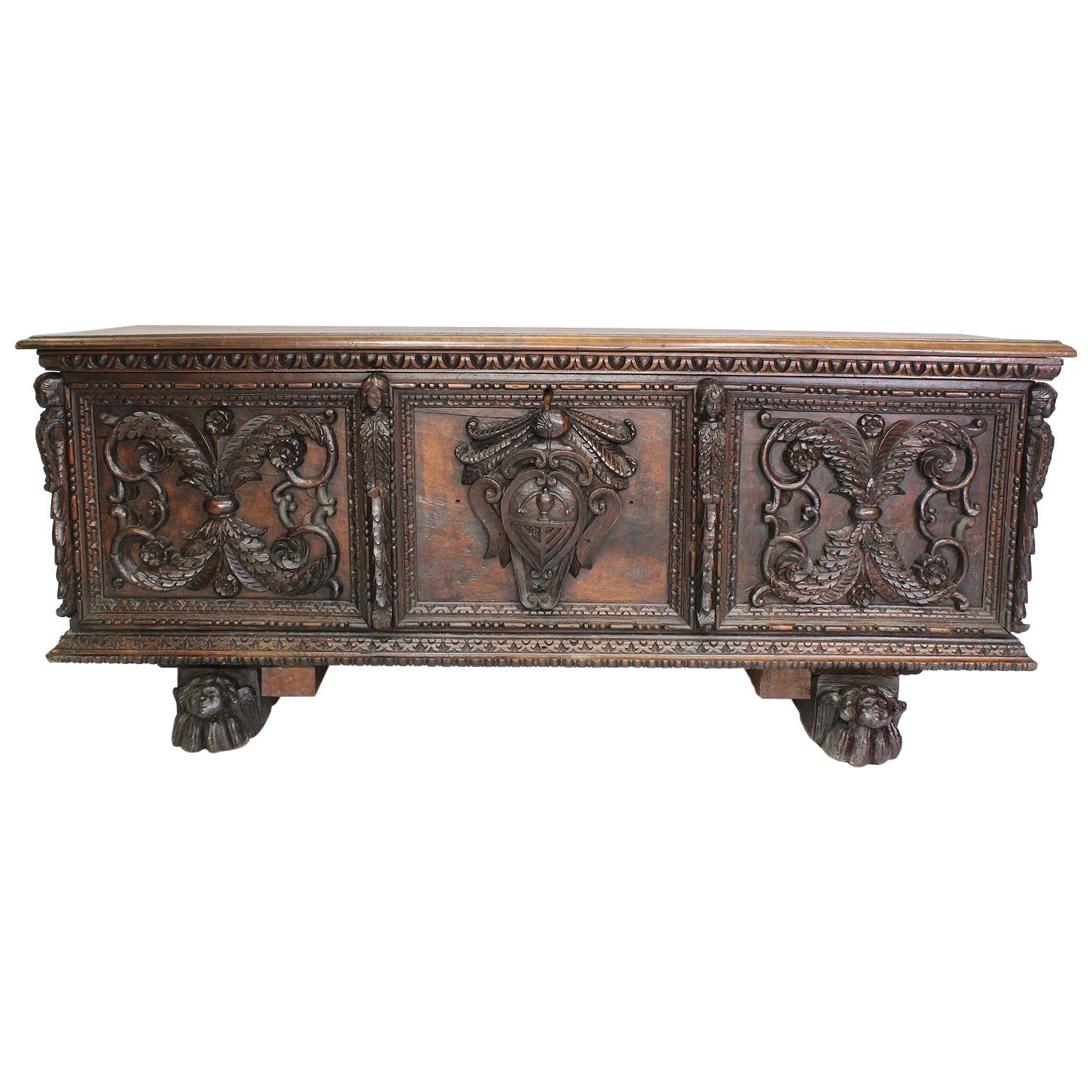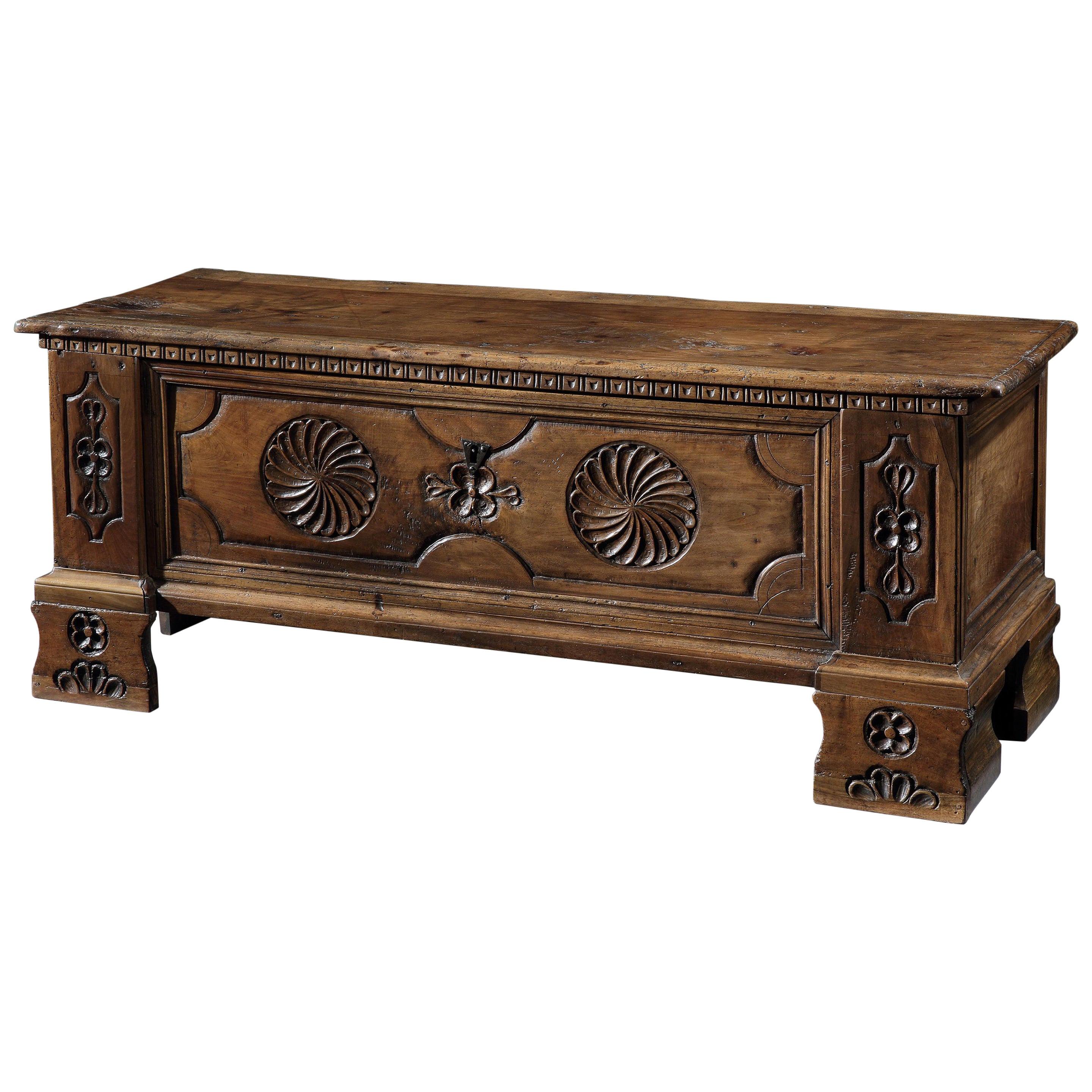Items Similar to Italian 19th Century Carved Walnut Cassone Chest with Putti and Winged Dragons
Want more images or videos?
Request additional images or videos from the seller
1 of 21
Italian 19th Century Carved Walnut Cassone Chest with Putti and Winged Dragons
About the Item
A Fine and Large Italian Florentine 19th Century Baroque Revival Style Carved Walnut Figural Cassone Chest on Stand. The ornately carved drop-front cassone with an allegorical in-relief carvings depicting playful Putti among satyrs, fruits and acorns, centered with a carved winged lion holding a shield, flanked on each side by pull-out drawer compartments, each with carvings of a single Putto. The swagged apron centered with carvings depicting two Putti resting on an allegorical male mask crowned with fruits and flanked by floral wreaths, ribbons and seashells, all raised with a pair of resting winged dragons. Circa: Florence, 1880-1890.
A cassone (plural cassoni) or marriage chest is a rich and showy Italian type of chest, which may be inlaid or carved, prepared with gesso ground then painted and gilded. Pastiglia was decoration in low relief carved or moulded in gesso, and was very widely used. The cassone ("large chest") was one of the trophy furnishings of rich merchants and aristocrats in Italian culture, from the Late Middle Ages onward. The cassone was the most important piece of furniture of that time. It was given to a bride and placed in the bridal suite. It would be given to the bride during the wedding, and it was the bride's parents' contribution to the wedding.
There are in fact a variety of different terms used in contemporary records for chests, and the attempts by modern scholars to distinguish between them remain speculative, and all decorated chests are today usually called cassoni, which was probably not the case at the time. For example, a forziere probably denoted a decorated chest with a lock.
Since a cassone contained the personal goods of the bride, it was a natural vehicle for painted decoration commemorating the marriage in heraldry and, when figural painted panels began to be included in the decor from the early quattrocento, flattering allegory. The side panels offered a flat surface for a suitable painting, with subjects drawn from courtly romance or, much less often, religious subjects. By the 15th century subjects from classical mythology or history became the most popular. Great Florentine artists of the 15th century were called upon to decorate cassoni, though as Vasari complains, by his time in the 16th century, artists thought such work beneath them. Some Tuscan artists in Siena and Florence specialized in such cassone panels, which were preserved as autonomous works of art by 19th century collectors and dealers, who sometimes discarded the cassone itself. From the late 1850s, neo-Renaissance cassoni were confected for dealers like William Blundell Spence, Stefano Bardini or Elia Volpi in order to present surviving cassone panels to clients in a more "authentic" and glamorous presentation.
A typical place for such a cassone was in a chamber at the foot of a bed that was enclosed in curtains. Such a situation is a familiar setting for depictions of the Annunciation or the Visitation of St. Anne to the Virgin Mary. A cassone was largely immovable. In a culture where chairs were reserved for important personages, often pillows scattered upon the floor of a chamber provided informal seating, and a cassone could provide both a backrest and a table surface. The symbolic "humility" that modern scholars read into Annunciations where the Virgin sits reading upon the floor, perhaps underestimates this familiar mode of seating.
At the end of the 15th century, a new classicising style arose, and early Renaissance cassoni of central and northern Italy were carved and partly gilded, and given classical décor, with panels flanked by fluted corner pilasters, under friezes and cornices, or with sculptural panels in high or low relief. Some early to mid-sixteenth-century cassoni drew their inspiration from Roman sarcophagi (illustration, right). By the mid-sixteenth century Giorgio Vasari could remark on the old-fashioned cassoni with painted scenes, examples of which could be seen in the palazzi of Florentine families.
A cassone that has been provided with a high panelled back and sometimes a footrest, for both hieratic and practical reasons, becomes a cassapanca ("chest-bench"). Cassapanche were immovably fixed in the main public room of a palazzo, the sala or salone. They were part of the immobili ("unmoveables"), perhaps even more than the removable glazed window casements, and might be left in place, even if the palazzo passed to another family.
A similar Cassone, most likely by the same Florentine cabinetmaker, was acquired in Florence in the 1880's by Grand Duke Vladimir Alexandrovich, the younger brother of the Emperor Alexander III of Russia. The Cassone is currently on display in the Vladimir Palace (the former official residence of GD Vladimir Alexandrovich) in St.Petersburg, Russia. An image of the Cassone at The Vladimir Palace is available upon request.
Jan's & Co. Fine French Antiques, Inc. would like to thank Nadia Smotkin in St. Petersburg, Russia, for providing us with this information.
Overall height: 52 1/8 inches (132.4 cm)
Overall width: 83 1/2 inches (212.1 cm)
Overall depth: 29 3/4 inches (75.6 cm)
- Dimensions:Height: 52.13 in (132.42 cm)Width: 83.5 in (212.09 cm)Depth: 29.75 in (75.57 cm)
- Style:Baroque Revival (In the Style Of)
- Materials and Techniques:
- Place of Origin:
- Period:
- Date of Manufacture:Circa: Florence, 1880-1890
- Condition:Repaired: Minor old touch ups and carving restorations. Wear consistent with age and use. Minor losses. Minor fading. A truly stunning carved cassone chest. Overall condition is very good with some age wear, minor carving losses/restorations, minor wood stress and fading. One key.
- Seller Location:Los Angeles, CA
- Reference Number:
About the Seller
5.0
Vetted Seller
These experienced sellers undergo a comprehensive evaluation by our team of in-house experts.
Established in 1982
1stDibs seller since 2016
113 sales on 1stDibs
Typical response time: <1 hour
- ShippingRetrieving quote...Ships From: Los Angeles, CA
- Return PolicyThis item cannot be returned.
More From This SellerView All
- Italian 19th Century Baroque Style Carved Walnut Figural Cassone Chest-TrunkLocated in Los Angeles, CAAn Italian 19th century Baroque Revival style carved walnut figural Cassone chest-trunk. The ornately carved chest, also known as a marriage chest, with ...Category
Antique 19th Century Italian Baroque Revival Commodes and Chests of Drawers
MaterialsWrought Iron
- French 19th-20th Century Baroque Revival Carved Oak Bombé Figural Bombé VitrineLocated in Los Angeles, CAA French 19th-20th century Baroque Revival carved oak Bombé figural vitrine. The single front-door display cabinet with bowed front and side beveled glass panels, with two interior g...Category
Antique Early 1900s French Baroque Revival Vitrines
MaterialsGlass, Oak
- Italian 19th Century Baroque Style Oak-Carved Figural Server Cabinet BuffetLocated in Los Angeles, CAA fine and rare Italian 19th century Baroque Renaissance Revival style oak-carved figural server cabinet. The upper part crowned with an architectural carving above a paneled shelf, ...Category
Antique Late 19th Century Italian Renaissance Revival Buffets
MaterialsMarble
- Fine French 19th Century Louis XV Style Walnut Carved 2-Door Provincial ArmoireLocated in Los Angeles, CAA fine and large French 19th century Louis XV style walnut carved two-door provincial armoire (wardrobe), the interior fitted with four pine shelves and with all original hardware an...Category
Antique 19th Century French French Provincial Cabinets
MaterialsWrought Iron
- Pair of Italian 19th-20th Century Baroque Style Walnut Carved Throne ArmchairsLocated in Los Angeles, CAA fine pair of Italian 19th-20th century Baroque Revival style walnut figural carved high-back throne armchairs, each upholstered in a floral cream silk and gold fabric...Category
Antique Early 1900s Italian Baroque Revival Armchairs
MaterialsFabric, Walnut
- Charming Italian 19th Century Carved Marble Group "Playful Putti with Goat"Located in Los Angeles, CAA very fine and charming Italian 19th century carved Carrara Marble Group "Playful Putti with Goat" depicting two young children, one riding the goat whose two front legs are in the ...Category
Antique 19th Century Italian Rococo Figurative Sculptures
MaterialsCarrara Marble
You May Also Like
- 19th Century Italian Carved Walnut Display CabinetLocated in London, GBAn Italian carved walnut vitrine. Constructed in carved walnut, rising from a serpentine ogee edged plinth base with a mirror back, having a central mythological winged figure flank...Category
Antique 19th Century Italian Baroque Revival Vitrines
MaterialsWalnut
- Mid 19th century carved walnut Italian cabinetLocated in Debenham, SuffolkGood quality carved italian two part cabinet cupboard, circa 1850. Beautifully carved in walnut, with good colour and patina. Features four carved panels on the doors of Spanish ge...Category
Antique Mid-19th Century Italian Gothic Revival Cabinets
MaterialsWalnut
- 15th Century Italian Cassone ChestLocated in Saint-Ouen, FRThis chest stands on a high moulded plinth. It was made from a fine walnut wood and shows good traces of polychromy and gold leaf decor. The facade’s two panels, once colourful, ...Category
Antique 15th Century and Earlier Italian Gothic Blanket Chests
MaterialsWalnut
- Wooden Chest Carved and Gilded Italy 19th CenturyBy Non-Standard Furniture and LightingLocated in Milano, ITChest built from wood dating back to the 17th century. Top and sides made of painted wood, undercounter frame and richly carved and gilded front depicting putti in the central reserv...Category
Antique Early 1800s Italian Other Cabinets
MaterialsGiltwood
- Cassone, 17th Century, Italian, Baroque, Vernacular, Walnut, Carved, HeartsLocated in BUNGAY, SUFFOLKThis handsome cassone has ornament with romantic associations and was most likely a marriage chest. It is a good example of the Italian vernacular, simple in a sophisticated manner. ...Category
Antique Late 17th Century Italian Baroque Blanket Chests
MaterialsWalnut
- Italian Walnut 19th Century Credenzino with Dentil Molding and Carved FeetLocated in Atlanta, GAAn Italian walnut credenzino from the 19th century with single drawer, petite double doors, carved dentil molding and feet. This Italian walnut credenzino from the 19th century is a ...Category
Antique 19th Century Italian Cabinets
MaterialsBrass
Recently Viewed
View AllMore Ways To Browse
Italian Window Benches
Tuscan Wedding Cassone
Wedding Bench
16th Century Cassone
End Of Bed Storage Bench
William And Mary Bed
Wedding Cassone
William And Mary Wing Chair
William Mary Wing Chair
Roman Cabinet
Low Bench With Storage
Pair Of Gilded Benches
Tuscan Bench
Corner Table With Storage
Pair Painted Beds
Carved Wedding Chair
Italian Cassapanca
Modern Bed With Storage





